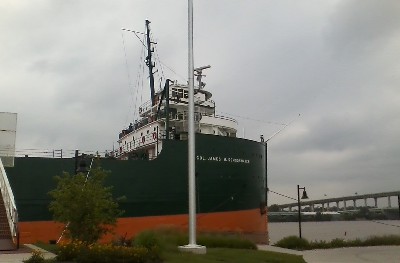

Mataafa Storm, 1905
Many vessels ran aground or were sunk on Lake Superior, November 28, 1905. The S.S. Mataafa ran aground and broke in two near Duluth.
Fifteen sailors on the Mataafa survived. This storm tracked into western Lake Superior with strong winds.
The Great Lakes Storm of 1913
In the terrible Great Lakes Storm of November 7-10, 1913, twelve steamships sunk and all the crew members died on those ships. Ships
were lost on four of the five Great Lakes.
The lowest pressure of this storm was 968.5mb on November 10th. This was a rather odd and surprising storm system
that tracked northward from Virginia to near London and Hamilton, Ontario.
The storm stalled such that very strong winds affected Lake Huron for a long time,
leading to very large waves. It also was a record-setting snowstorm for Cleveland, OH.
Before the storm, first engineer Milton Smith of the S. S. Charles S. Price had some sort of bad feeling or premonition. He decided
to stay at Cleveland, and he abandoned his post on the ship. Just days later, Smith was identifying dead bodies of his former
crewmates, some of which had washed up on the Lake Huron shoreline.
Quotes from the Toledo Blade:
Diver tries to learn name of lost vessel, believe it is Regina
Storm is called worst in history of Lake trade
S.S. James B. Colgate, 1916
Three ships sunk on October 20, 1916. S.S. James Colgate, The barge D.L. Filer, and the S.S. Marshall Butters. The S.S. James B. Colgate sunk
near Long Point, Ontario, Lake Erie on October 20, 1916 in strong winds.
S.S. Myron, 1919
The S. S. Myron sunk in Lake Superior in a 60mph wind on November 22, 1919. The Myron lost speed as water was flowing into
the cargo area.
Miztec, 1921
The Miztec was being towed by the S.S. Myron when the Myron sunk in 1919. The Miztec was damaged, but survived that snowstorm. It
sunk in a May 13, 1921 in a May snowstorm, on a Friday the 13th.
S.S. City of Bangor, 1926
The S.S. City of Bangor ran aground on November 30, 1926 on the shores of the Keweenaw Penninsula of Michigan. There were fierce gale force winds,
large waves and heavy snow. The crew were saved. In February 1927, some 200 Chrysler automobiles on board the City of Bangor
were salvaged after they were chipped out of the ice and driven down a ramp made of snow.
The Armistice Day Storm of 1940
The Armistice Day Blizzard of November 11, 1940 caused three shipwrecks on Lake Michigan. The S.S. Anna C. Minch, the S.S. Novadoc, and the S.S.
William B. Davock. All three sunk near the central Michigan shoreline. Large waves developed with
very strong southwesterly winds on Lake Michigan.
This bomb low pressure tracked from Kansas to western Lake Superior and reached a low pressure of 971mb near Lake Superior.
The S.S. Henry Steinbrenner, 1953
The S.S. Henry Steinbrenner was lost on May 11, 1953 in an unusual spring storm that hit the ship with 80mph winds on Lake Superior.
It sunk 15 miles south of the Isle Royale Light, and a few men were saved.
The S.S. Carl D. Bradley, 1958
On November 18, 1958, the S.S. Carl D. Bradley sunk in northern Lake Michigan with strong westerly gales.
The lowest pressure of this storm was 974mb in Minnesota.
500mb loop of the Carl D. Bradley storm
The S.S. Daniel J. Morrell, 1966
On November 29, 1966 in a fierce northerly gale on Lake Huron, The S.S. Daniel J. Morrell was wrecked by the waves and winds.
The only survivor was Dennis Hale. He said a ghostly figure helped him survive for many hours before he was saved from the icy waters by the USCG.
The lowest pressure of this storm was about 985mb, near Toronto Ontario.
500mb loop of the Daniel J. Morrell storm
Surface temp/SLP
500mb vorticity/ Nov 29, 1966
The S.S. Edmund Fitgerald, 1975
On November 10, 1975, a strong low pressure was tracking out of the southern Plains and Midwest, towards Lake Superior. On November 9th, The S.S. Edmund
Fitzgerald and S.S. Arthur M. Anderson were making a late-season run to haul iron ore to Detroit. The two ships sailed east and north, to
avoid large waves from northerly winds. As they moved toward Whitefish Point in eastern Lake Superior on November 10th., the
low pressure had crossed the lake and the winds shifted to northwesterly. Unfortunately, the two ships were hit with 25-35 foot waves
and 70-85 mph wind gusts. The Anderson lost contact with the Edmund Fitzgerald at 7:10PM on November 10th. A rescue effort came shortly after this, as the
Arthur M. Anderson and other vessels went back into the storm to look for survivors. The Fitzgerald was lost, though. It must have sunk suddenly.
The captain of the ship, Captain Ernest McSorley, was a Canadian man who lived in Toledo OH (Ottawa Hills, OH).
Youtube: SHIPWRECK: The Mystery of the Edmund Fitzgerald
500mb/vorticity loop of the Fitzgerald Storm
Edmund Fitzgerald Storm SLP loop
Edmund Fitzgerald Storm 500mb loop
1. The 11/11/11 Cold Wave (cold wave and tornadoes, Nov. 11, 1911)
2. Great Lakes Storm of 1913
3. Armistice Day Blizzard
4. Edmund Fitzgerald Storm
5. Veterans day lake-effect snow of November 9-14 1996, northeast Ohio
6. Strong low, damaging wind gusts and tornadoes, November 10, 1998
7. Veterans Day tornado outbreak, 2002
8. Even in 2015, low pressures seem to like Minnesota on November 11th. (985 mb in Iowa/Minnesota).
This web site began in 2004. The purpose is to provide high quality information on historical storms
and provide links to weather information.